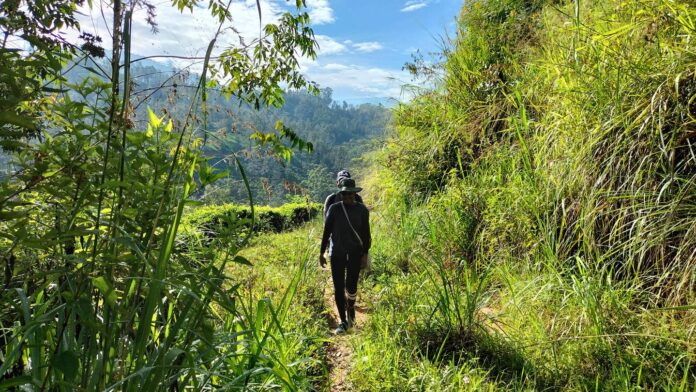“We’re going to travel better.” That’s what many optimists said back in the early days of the pandemic, when countries had sealed their borders, airline fleets were grounded and virus-hit cruise liners struggled to disembark passengers.
Fast forward to 2023 and the idea of “revenge travel” — holidaying as a way of making up for lost opportunities during the pandemic — coupled with buoyant growth forecasts for the tourism industry, despite a looming worldwide recession, might suggest that the idea was little more than a short-lived fantasy.
But perhaps not.
While the phrase revenge travel conjures up negative connotations, tourists having more money to spend on holidays could result in a greater willingness to invest in sustainable travel experiences.
On the other side of the coin, many destinations are bolstering their responsible offerings, keen to put lessons learnt during the Covid-19 crisis into action.
A great example is the tiny western Pacific island of Palau — a place that’s long been a champion of sustainable travel. The archipelago has introduced the world’s first “good traveller” initiative. The Ol’au Palau scheme gives tourists exclusive experiences and access to new places based not on how much they spend, but on how they engage with the environment and local culture during their trip.
For travellers keen to explore more destinations that won’t trouble their conscience, these 10 destinations offer opportunities to travel better this year.
1. Menorca, Spain
The island of Menorca is celebrating its 30th anniversary as a designated Unesco Biosphere Reserve this year and the easternmost of Spain’s Balearic Islands continues to champion travelling better.
Unlike its rowdier siblings, Ibiza and Majorca, Menorca has long prided itself on its breathtaking natural attributes. More than 40 per cent of the island is protected.
Towards the end of last year, the Balearic Islands announced a new $60-million sustainable tourism initiative that will result in all hotels and guesthouses installing water-saving devices, limiting the use of paper and plastic, optimising electricity use and switching from oil to natural energy sources. The plan also champions the use of locally sourced food, with seafood from the surrounding Mediterranean Sea becoming traceable under the new law.
Travellers looking to explore the island can try Pura Aventura’s new inn-to-inn, self-guided walking tour along Menorca’s unspoilt north coast. Specialising in sustainable holidays away from the crowds, Pura’s trip takes in some of the region’s best landscapes, over the course of nine days. Meandering along the finest sections of the 185km Cami de Cavalls 360º, it gives visitors the chance to explore the sun-soaked island paradise while meeting local hosts and learning more about the region’s culture and traditions.
2. Kandy, Sri Lanka
Emerging from a tumultuous 2022 that paired the global pandemic with a full-blown economic and political crisis, Sri Lanka is ready to welcome visitors again, with a new sustainable hiking trail on its books.
The Pekoe Trail is a 22-day, 300km network of trails that winds through Sri Lanka’s tea country. Funded by the European Union and USAID, the project has been 10 years in the making. Officially set to launch in June this year, sections of the trail are already open for tourists keen to get a head start.
Starting in Kandy, the trail crosses over seven valleys, the country’s eastern hills and some of its most dramatic terrain. Designed as a thread that connects many of the region’s highlights, it takes in spots such as Adam’s Peak, Lipton Seat, the Nine Arch Bridge and Adisham Hall, but also opens up many as-yet undiscovered areas to travellers.
“Like the Camino de Santiago, the Inca Trail, the Appalachian Trail, the Transcaucasian Trail, the Milford Track, the Sunshine Coast Trail, Red Sea Mountain Trail and so many others, we want this walking journey to be a space for exchange between people and a riveting source of storytelling,” says Miguel Cunat, heritage trail adviser for the Pekoe Trail.
As well as giving visitors the chance to immerse themselves in nature, the trail is also designed to promote the diverse cultural and natural heritage of the region and encourage its preservation by benefiting local communities. Guests can book to stay at unique accommodations such as Haldummulla Estate, AMBA organic farm and forest reserve and Camellia Hills in Dickoya.
3. Nazareth, Palestine
Following the signing of the Abraham Accords in 2020, many airlines have launched new flights to Israel — the easiest hub for getting into Palestine — boosting tourism to the country.
Tour operators can arrange transfers from Tel Aviv to Palestine and there’s an abundance of historical, religious and cultural sites waiting to be discovered. Palestine’s small size doesn’t mean it is one-dimensional — travellers can experience a whole range of landscapes, from farmed valleys to mountain peaks, even on a short trip.
Tourists exploring Israel can make their trips more sustainable by including stops in Palestine on their itineraries to help fund equal distribution across the land. The Palestinian Initiative for Responsible Tourism encourages tourists to visit both destinations, to give people in each place the chance to share their culture and tell their own stories in an effort to foster tolerance and greater understanding.
There’s plenty to see and do in Palestine, with a range of community tourism projects, hiking trails and biking adventures on offer. The Siraj Centre has been operating for more than 18 years and has a wide range of responsible tourism programmes on offer. One such trip, taking place in March this year, is the Nativity Trail, a multi-day hike traversing Palestine and featuring homestays, cultural sites and more.
Starting in Nazareth, the tour takes in places such as Mount Tabor, Nablus, Bethlehem, Awarta and the Dead Sea. It passes pine-covered forests, winds onwards to Al Auja Spring, one of the largest water sources in the Jordan Valley, and includes a visit to Far’a refugee camp, where travellers will have dinner with local families living in the camp.
During a trip to Palestine, travellers can also stay in The Walled Off Hotel in Bethlehem, a boutique hotel designed by British street artist Banksy. Boasting “the worst view in the world”, it overlooks the towering wall that greets visitors driving from Israel to the West Bank and has nightly piano recitals featuring exclusive arrangements from Jarvis Cocker and Chilly Gonzales. Later this year, the hotel will host a month-long exhibition titled Imagine Freedom, where guests can see works from young Palestinian artists around the world.
4. New South Wales, Australia
After battling some of the world’s toughest Covid-19 restrictions, Australia is fully open to tourists again, with several new sustainable travel initiatives in place.
The introduction of a scorecard programme from Ecotourism Australia and Tourism Australia lets hotels, tour operators, restaurants and other businesses complete official assessments to show how well they’re doing when it comes to their environmental, cultural and socio-economic impact, as well as giving travellers transparent information to help them make responsible bookings.
In Sydney, enjoy a once-in-a-lifetime experience on the water with Tribal Warrior. On Sydney’s only First Nations-owned and operated Aboriginal cultural cruise, passengers can hear the stories of Australia’s native people and learn the Aboriginal names and significance of local landmarks.
Travellers keen to learn more about that history can head to Mungo National Park in New South Wales — a place thought to be home to the oldest culture on earth after the discovery of the Aboriginal Mungo Lady and Mungo Man remains there.
Australian Wildlife Journeys has a citizen science trip in the national park that lets travellers get hands-on when it comes to sustainable travel — helping to erase the impact of climate change and feral species intrusion on biodiversity in the park.
From spotting emus to counting seeds, logging daily wildlife spots and contributing to the Koala Clancy Foundation, which plants trees to create new habitats for the furry creatures, this is an easy way for travellers to leave Australia a little bit better off than when they arrived.
5. Azores, Portugal
Dubbed the Hawaii of Europe, Azores and its nine islands are known for their pristine surroundings, whale-watching opportunities and natural hot springs.
The temperate mid-North Atlantic Portuguese territory has long championed sustainable tourism — four of the islands are Unesco biosphere reserves. It was also the first archipelago in the world to be certified as a sustainable tourism destination by the Global Sustainable Tourism Council.
For this year, the country’s tourism strategy centres around conservation and biodiversity protection. The islands are also the latest addition to the Kuoni Europe collection for 2023.
The luxury operator has added several accommodation options on the islands to its itineraries, including the Santa Barbara Eco-Beach Resort, which is all about wellness and eco-tourism, The Shipyard Angra in the main city of Terceira Island, which has been created out of an old warehouse, and the Zenite Boutique Hotel & Spa, where guests can bed-down in a meticulously restored 18th-century building in the heart of a Unesco-listed town.
6. The Okavango Delta, Botswana
Known as one of the world’s greatest safari destinations, Botswana is precious about its wild spaces, with almost 40 per cent of the country officially earmarked as protected land. Authorities also carefully monitor the number of tourists allowed to visit each year, limiting them to prevent overtourism. This means visitors can expect crowd-free safaris in some of the world’s most pristine wetlands and prairies.
The Botswana Tourism Organisation also has super strict rules regarding lodges and camps, all of which must be deconstructable within 24 hours and removable without a trace. Following these rules and opening in June is North Island Okavango by Natural Selection, an exclusive retreat made up of only three tents on a private island in northern Botswana.
Surrounded by floodplains, open savanna and forests, the 100 per cent solar-powered lodge in the Okavango Delta is one of the best places in the entire country for wildlife lovers. Guests staying at the luxury hideaway can head out on traditional mokoro safaris — sitting in wooden dugout canoes similar to those that the local people once used as a principal form of transport. Silently meandering along reed-lined waterways and lily-filled channels, travellers can come face to face with buffalo, hippos, crocodiles and more.
Natural Selection also offers visits to a nearby village — a good way to see how the lodge and others like it are driving community tourism, and there’s the option to spend time with the resort’s conservation partners to find out more about wildlife conservation in this southern African nation.
7. Gothenburg and West Sweden
It’s perhaps no great surprise that Sweden’s second-largest city makes it to this list of places to travel better. The west-coast port city has topped the Global Destinations Sustainability Index since 2016 and more than 95 per cent of its hotels are eco-certified.
This summer is a good time to visit as Gothenburg is finally celebrating its 400-year anniversary — after initial plans in 2021 were cancelled due to the pandemic. There’s a whole schedule of festivals, workshops and events taking place to mark the occasion, including plans to transform some of the city’s public spaces into an open-air exhibition under the tag Prototyping Gothenburg.
Set along a walking path that stretches from Frihamnen — a new neighbourhood in the city’s old shipbuilding port — through the centre and towards historic parts of the city, it reflects Gothenburg’s development from foundation to the present and highlights initiatives in place throughout the region that are actively accelerating sustainable change.
Once you’ve explored the city, head out to the West Coast Way where there are hundreds of islands and islets to be discovered. Getting there is easy — Sweden’s public transport system is exceptionally efficient — both in terms of timekeeping and sustainability.
Catch the ferry to the car-free island of Styrso — only 45 minutes from the city — where sandy beaches, walking paths, a snorkelling trail and cosy cafes await. Or go farther afield to Hono, where family-friendly bike trails and harbour seal-watching trips are on offer. Adventurers can also opt to hike the 71km walking trail between Gothenburg and Alingsas, which promises four days of undulating countryside, wild swimming spots and restaurants where the focus is on authentic west Swedish delicacies.
8. Bhutan
Nestled among the Himalayas, remote Bhutan kept its borders tightly sealed for more than two years during the pandemic, only easing restrictions in September. With the reopening came a new sustainable tourism strategy, focusing on climate-friendly experiences and carbon-neutral tourism.
Long known for its “high value, low impact” approach to tourism, the mountain kingdom’s sustainable development fee for most travellers has been increased to $200 per adult per day. Some of Bhutan’s most famous sites — including the Tiger’s Nest Monastery and Punakha Dzong — also charge entry fees now. All this means trips to the already exclusive destination are even more expensive, so over-tourism isn’t something Bhutan needs to worry about.
For those who do have the funds, Bhutan guarantees unique cultural insights, crowd-free temples and uninterrupted access to ancient treasures.
The country’s restored, historic, 400km Trans-Bhutan Trail is a must-do. Having reopened for the first time in six decades last year, this trail was used by pilgrims, armies and traders for thousands of years and, until the 1960s, was the only way to travel across the country. A member of the World Trails Network Sustainability Committee, its enhancement is billed as a sign of respect for Bhutan’s ancestors and a way to bring economic benefit to the remote communities along its way.
The non-profit Trans-Bhutan Trail organisation offers a host of sustainable tours that explore the route, with all funds either going back into its upkeep or to the communities who call it home. New for this year are a women’s adventure tour led by female Bhutanese guides, a 100km mountain biking homestay adventure and a challenging 35-night end-to-end hike.
9. New Mexico, US
Blessed with mountain peaks, hot springs and an abundance of natural landmarks, the state of New Mexico in south-west US easily lives up to its nickname, the Land of Enchantment.
High elevations, low populations and a dry climate mean it is brimming with “dark sky destinations” where travellers can try stargazing — an experience that is both sacred and spiritual for New Mexico’s indigenous people. The state is home to 23 pueblos, tribes and nations, and travel company Heritage Inspirations is offering several new tours this year to allow travellers to find out more about life in the region before it became part of the US.
On the radar for the year are trips to the Chaco Canyon — an international dark sky park that’s home to the biggest set of ancient Native American ruins north of Mexico — and a stargazing glamping experience in Unesco-listed Taos, the northernmost of New Mexico’s pueblos.
In popular Santa Fe, continue discovering ancient secrets with a stay at Hotel Santa Fe, the city’s only Native American-owned hotel. Operating for more than 25 years, it offers a tradition-centric retreat in the foothills of the Sangre de Cristo Mountains that celebrates the culture and spirit of the Pueblo people. It’s also home to a multi-million dollar art gallery, depicting the Picurius Pueblo story.
In New Mexico’s south, travellers looking for a conservation-focused stay can spend a night at the recently opened Hacienda inside Ted Turner’s 145,687-hectare Armendaris property in the Chihuahuan desert. Best known as the media mogul who founded CNN and Jane Fonda’s ex-husband, Turner is also a conservationist and owns three ranches across New Mexico, designed to give visitors a unique appreciation for nature.
10. Belfast, Ireland
Northern Ireland’s capital earns its spot on this list of places to travel better after extensive efforts to transform itself into one of the world’s greenest and most sustainable destinations.
Initiatives such as certifying nearly 70 per cent of its hotels as sustainable, along with plans to plant a million native trees across the city earned it eighth place in the 2022 Global Destination Sustainability Index.
On the River Lagan, Titanic Belfast is one place where travellers can visit conscience-free — it was the first business in Ireland to win a green tourism award.
The angular-shaped building sits at the site where the Titanic was built and gives visitors an immersive, state-of-the-art look at the creation of the world’s most famous ocean liner. Closed for a multimillion-dollar refurbishment, it will reopen in late February with a brand new experience called The Pursuit of Dreams, highlighting the city’s maritime heritage.
Sustainably minded travellers looking for a place to lay their head will be excited to learn that room2 Belfast will welcome guests in spring. Run by the same company that launched the world’s first net-zero carbon hotel in London in 2021 — the unique “hometel” concept brings 175 sustainably designed rooms, green energy and its zero waste concept to Ireland for the first time.
Updated: January 05, 2023, 11:27 AM










